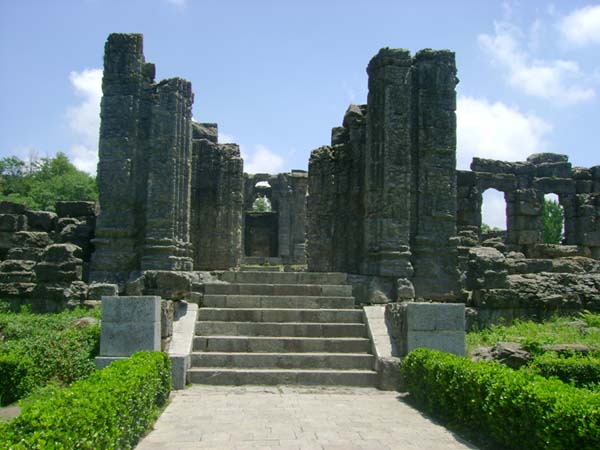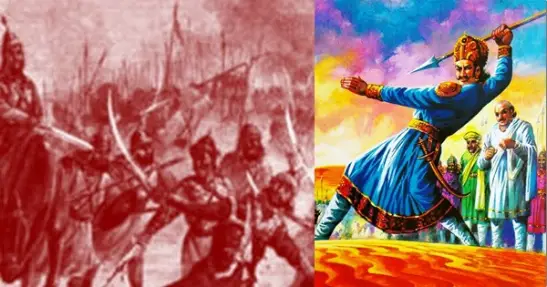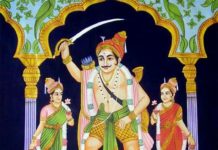Lalitaditya Aka Muktapida was a powerful ruler of Kashmir in the 8th century and credited being a world conqueror. He was called as Alexander of India and ruled for 36 years, 7 months and 11 days as part of Karkota dynasty. He was addressed as Muktapida too. He had two wives and two sons – Kuvalayapida from Kamaladevi and Vajraditya II from Chakramardika.
Lalitaditya Muktapida Of Kashmir Information
| Reign | 724 CE - 760 CE (8th century) |
| Ruler | King of Kashmir |
| Dynasty | Karkota |
| Religion | Hinduism |
| Parents | Durlabhaka and Shrinarendraprabha |
| Elder brothers | Chandrapida and Tarapida |
| Spouse | Kamaladevi and Chakramardika |
| Sons | Kuvalayapida and Vajraditya |
| Successor | Kuvalayapida |
Why Lalitaditya was addressed as Muktapida
There is no confirmed theory on it as why Lalitaditya was also named as Muktapida, but 11th century Persian writer Al-Biruni wrote in one of his books that on the second day of Chaitra month people of Kashmir celebrated the alleged victory of their past King Muttai over the Turks. The word Muktapida has been derived from Muttai and it refers to Lalitaditya. Al-Biruni added that Kashmiris then claimed Muttai and most of the other kings of the region ruled over the whole world.
Lalitaditya Muktapida: Alexander of India Who Defeated Arabs and Controlled Turks
Chandrapida was sworn in as King of Kashmir after the death of Pratapaditya. He ruled for seven years courageously and served as great valor. He was humble and generous too. He suddenly died and Tarapida took over the throne. Reason of death is still not known.
Tarapida was not comparatively brave. He showed poor administrative skills. Misgovernance was common during his brief reign of one and half years. He died of a stroke.
Lalitaditya took the throne thereafter and he was then just 20. He became King of Kashmir at such time when western invasion started and Arabs had occupied province of peshawar, multan, swat and Kingdom of Sindh. He faced threat from Arab king Mohammad Bin Qasim to occupy Kashmir and central India.
Showing his bravery Lalitaditya first chose to tackle couple of conventional enemies and fought the bhuttas of ladakh, kabhojas and daradas. He led the army himself and defeated kings of the regions. He established control.
With the support Yashovarman, King of Kannuj and whose Kingdom consisted of Jharkhand, Chhattisgarh, Bihar, UP and parts of Bengal, he defeated the Arabs and stopped from entering Kashmir.
The defeat of Arabs was not as simple as it sounds. It involved diplomacy policy of Lalitaditya too. He approached the Tang Dynasty, which was at the top of power during the 7th century but lost several central China territories to Tibetan Empire. Lalitaditya managed to convince him in fight against Arabs and Tibetans. Advanced infantry armor and heavily armored Sassanid-Chinese cavalry were provided by the Chinese ruler and the two defeated Tibetans and conquered Kucha as well as Turfan. The Tibetan also lost control of Bangladesh and Assam to Lalitaditya.
The Arabs were ordered to shave off half heads as symbol of submission and Lalitaditya went on to conquer Dardistan, which was part of Pakistan in north, Kashmir in India and some parts of north-eastern Afghanistan.
His effort to teach lesson to the Arabs didn’t stopped here. He also conquered Turkestanand Transoxiana, which was part of Central Asia (modern-day Uzbekistan, Tajiskitan, southern Kyrgyzstan and southwest Kazakhstan).
Lalitaditya thereafter invaded Turkestan via Kabul and defeated Mumin Bukhara in all the four wars. The ruler finally surrendered to him and agreed paying taxes as a respect.
After all such successful wars Lalitaditya expressed desire to conquer the world. He acquired most of the places in India. His kingdom extended to central China and so he was compared with Alexander the great.
During the last phase of his rule he became the most powerful king and gained enormous wealth. His military was most powerful in India and central Asia. His kingdom extended from Tibet to Iran and to Turkestan.
Lalitaditya Muktapida’s military career
Lalitaditya was an universal monarch. A good part of his life was spent in military expeditions. He invaded Antarvedi country and defeated Yashovarman after a long war. The land of Kanyakubja, capital city of Antarvedi with modern name as Kanauj, came under the control of Lalitaditya. Consolidating power here he proceeded to eastern ocean and reached Kalinga and Gauda.
Lalitaditya further proceeded to Kamatas in southern region, to Dakshinapatha, seven Konkanas, Dvaraka, Avanti, Uttarapatha and more. He returned back to Kashmir with huge volume of wealth that were obtained from the conquests.
Karkota Dynasty / Karkota Empire

The Karkota Empire spanned between 625 CE and 885 CE (7th and 8th century). Durlabhvardhana founded the dynasty to mark rise of Kashmir as a power in Northern India during liftime of Harshavardhan. The dynasty came to an end in 885 AD and it was the rise of Utpala dynasty and Avanti Varman ascended the throne of Kashmir.

Lalitaditya was the strongest rule of Karkota dynasty and he captured parts of Central Asia, Afghanistan and Punjab.
LaLalitaditya Muktapida from the book of Kalhana
A Kashmiri named Kalhana authored Rajatarangini in 12th century containing information on history of Kashmir. He characterized Lalitaditya in it as a world conqueror and credited him to have miraculous powers. He described him as a universal monarch.
What is Rajatarangini
Rajatarangini is a chronicle in Sanskrit of rulers of north-western Indian subcontinent. It mostly covered kings of Kashmir in 7826 verses divided into eight books called Tarangas.
Kashmiri historian Kalhana wrote Rajatrarangini in the 12th century CE and in today’s era offers invaluable source of information about the region.
Literal meaning of Rajatarangini is “The River of Kings” and the word Tarangas mean “waves”.
Cities and towns built by Lalitaditya Muktapida
Lalitaditya has been credited with building several towns and cities during his rule of about 36 years and one of the most known and beautiful one was his capital city Parihaspore (Parihaspur, Paraspur or Paraspore), which was built on a plateau above river Jhelum, northwest of Srinagar, in an area of 22 kilometers.
Lalitaditya built four temples including one of Lord Vishnu in Parihaspore. It is mentioned in Kalhana he used 84,000 tolas of gold to make the idol of Vishnu for the temple. He had built a tall statue of Buddha made of copper.
The other towns and cities built by Lalitaditya included Sunishchita-pura, Darpita-pura, Phala-pura, Parnotsa and Lokapunya.
Shrines built by Lalitaditya Muktapida
Lalitaditya was highly religious as it is evident from his efforts in building Hindu temples and shrines. He had constructed shrines everywhere, at leaast one in every village, town, river, sea and island. Those were Vishnu shrines, Buddhist Shrines, Shiva Shrines and Surya Shrines.
He dedicated the Vishnu Shrines to various aspects of Lord Vishnu, Lord Nirhari and Lord Muktasvamin. In Dapitapur he constructed shrine of Keshava. In Hushkapura he built shrine of Lord Muktasvamin. Similarly he constructed image if Nirhari in Strirajya and it was suspended in air with magnetic support from above and below.
In his capital city Parihasapura he built several images of Vishnu. One was image of Parihasa-Keshava which was made of 84,000 palas of silver. Another was image of Mukta-Keshava constructed of 84,000 tolakas of gold. Simultaneously he built images of gold Maha-Varaha and silver Govardhana-Dhara.
He worshipped vahana of Lord Vishnu too and had constructed a tall, giant pillar of height 54 hands consisting of an image of Garuda on the top.
Martland Sun Temple
Martland refers to Sun God and the temple was built by Lalitaditya in the 8th century, during 725-756 CE, by Lalitaditya. However, foundation of it is learned to have been around since 370-500 CE and Ranaditya attributed its construction.
In the early 15th century it was destroyed by Muslime ruler Sikandar Butshikan and the demolition lasted for about a year.
Lalitaditya Muktapida’s pathetic death
His death was pathetic. It was away from home. He had the quest of reaching to the region where no one has reached before. He marched towards boundless regions of the north and during the campaign he faced adventures with demons, which were dent by deity Kubera.
For several days his ministers didn’t receive any news about him and a messenger was sent in search of him. The messenger returned with the information Lalitaditya did not want to return and seeking to continue his military conquests until his death. In the message he provided his political vision about governing of his kingdom and asked elder son to become his successor. Later it was learned he died in the Aryanaka country due to high out-of-season snowfall.
There is a second theory of his death. It is believed he immolated himself in a dire situation as he wanted to die while remaining a king.





Someone in India should step forward and write a book on the life of King of Kashmir Lalitaditya . Amish who is an excellent writer is perhaps the only one who can perhaps do justice to this. India badly need good writers who can pick up historical heroes and write in details about them. Youth in India have no idea that such heroes exist.
you can always mail us similar stories and we shall publish them – contact us at snathandharma@gmail.com